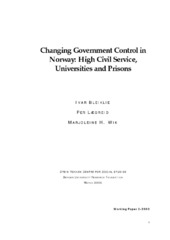| dc.contributor.author | Bleiklie, Ivar | eng |
| dc.contributor.author | Lægreid, Per | eng |
| dc.contributor.author | Wik, Marjoleine Hooijkaas | eng |
| dc.date.accessioned | 2006-06-21T15:22:27Z | |
| dc.date.accessioned | 2020-12-10T06:31:20Z | |
| dc.date.available | 2006-06-21T15:22:27Z | |
| dc.date.available | 2020-12-10T06:31:20Z | |
| dc.date.issued | 2003-03 | eng |
| dc.identifier.issn | 1503-0946 | |
| dc.identifier.uri | https://hdl.handle.net/1956/1405 | |
| dc.description.abstract | The topic of this paper is the changing relations of control between the legislative and executive bodies, within executive and within public administration. We outline the traditional way of controlling public sector organization in Norway up to the end of the 1970s and describe the main changes over the past generation by focusing on the comprehensive administrative reform programs and also on the main changes in the control forms of the parliament and introduction of new external control from the EU. We discuss how the control has changed the high civil service by focusing on the relationship between the parliament and the executive and within the executive. A special analysis is conducted of control within two specific policy areas: higher education and prisons. The focus is on four basic types of control: mutuality, competition, contrived randomness and oversight as broad ways of controlling public sector units. The conclusion is that there seems to be a general growth of control over time, first of all because enhanced use of competition and oversight by performance assessments. In contrast to what one could expect from the decentralization and deregulation components of the New Public Management movement, there seems to have been an increase in the formality, the intensity and the complexity of control over the past 10 years. | en_US |
| dc.description.abstract | Dette notatet fokuserer på endringar i kontrollrelasjonar mellom Storting og regjering, innafor sentraladminsitrasjonen og i statsforvaltninga. Vi gjer først greie for tradisjonelle kontrollformer i norsk offentleg forvaltning fram til slutten av 1970-åra. Deretter blir dei viktigaste endringane i løpet av dei siste 20 åra kartlagt ved å fokusere på moderningseringsprogramma, endringar i Stortingets kontrollformer og i nye kontrollordningar frå EU. Vi diskuterer korleis kontrollen har endra seg i sentralforvaltninga og i relasjonen mellom storting og regjeringsapparat. Det blir fokusert spesielt på endringar i kontrollrelasjonar innafor to policyområde: universitetssektoren og fengselsvesnet. Det blir lagt vekt på fire grunnleggjande generelle kontrollformer: kollegakontroll, stikkprøve-kontroll, konkurranse og tilsyn. Konklusjonen er at det ser ut til å bli auka kontroll over tid, først og fremst på grunn av auka innslag av konkurranse og resultatkontroll. I motsetnad til det ein kunne venta ut frå fristillings- og dereguleringskomponentane i New Public Management-reformene, ser det ut til å bli auka formalisme, intensitet og kompleksitet i kontrollformene i løpet av dei siste 10 åra. | no |
| dc.format.extent | 194621 bytes | eng |
| dc.format.mimetype | application/pdf | eng |
| dc.language.iso | eng | eng |
| dc.publisher | Stein Rokkan Centre for Social Studies | eng |
| dc.relation.ispartofseries | Working paper | en |
| dc.relation.ispartofseries | 2-2003 | en |
| dc.title | Changing Government Control in Norway: High Civil Service, Universities and Prisons | eng |
| dc.type | Working paper | eng |
| dc.subject.nsi | VDP::Samfunnsvitenskap: 200 | nob |
